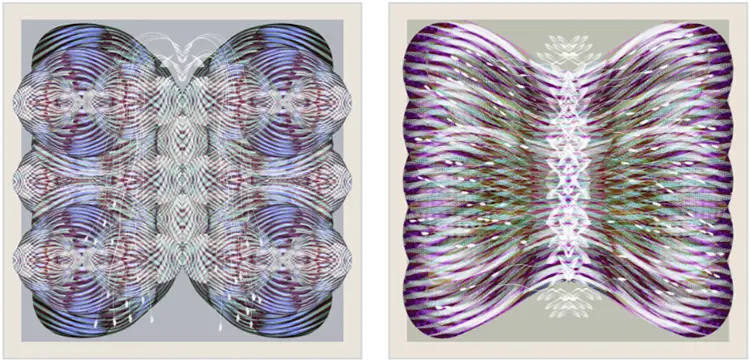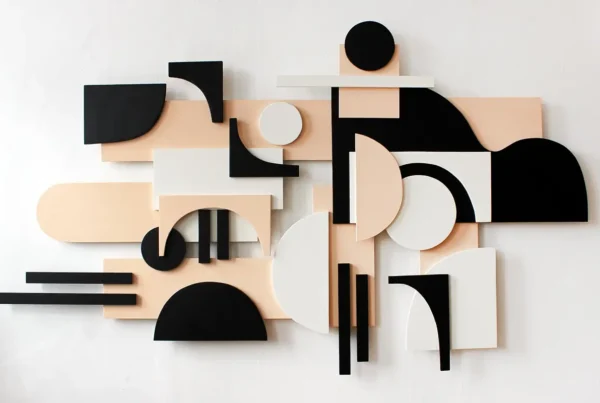“I gave myself a challenge: to create one artwork a day for 200 days. That practice was both a form of healing and a rediscovery of play.”
The Thread and the Line: From Childhood to Composition
In Olga Burkard’s world, artistry is not a profession as much as it is a mode of being—shaped by observation, inherited skills, and a lifelong fascination with structure. Born and raised in Mexico, and now based in Geneva, she carries within her the juxtaposition of two influential forces: her mother’s craft as a tailor and her father’s scientific inquiry. This combination of hands-on creation and analytical thought echoes strongly in her approach to visual expression. The quiet rhythm of scissors slicing through fabric and the meticulous nature of experimentation left a lasting imprint on her perception, one where precision and intuition coexist without conflict.
Her formal education deepened this dual affinity. Burkard studied Graphic and Textile Design at the Universidad Iberoamericana in Mexico City, a foundation that was later expanded through a Master’s in Graphic Design at the renowned Schule für Gestaltung in Basel. These academic environments sharpened her awareness of visual rhythm, balance, and the subtle power of form. Rather than being purely theoretical, these principles became integral to her practice, guiding her as she navigated the tension between artistic freedom and structural discipline. Her work today reflects this duality—rooted in emotional response but structured by the logic of design.
Though her early years were filled with drawing and imagination, Burkard did not immediately pursue a career as an artist. She spent significant time in the design industry, working as a designer and art director and co-founding a communications agency that catered to global clients. Creativity was a constant, but it was channeled through the demands of branding and client directives. It wasn’t until a deeply personal moment shifted her course that she embraced her identity as an artist fully. Challenging herself to create one piece of art every day for 200 days became both an emotional reset and a reclaiming of creative joy. That intense, daily process not only reawakened her imagination but also anchored her artistic commitment, setting her on an irreversible path.
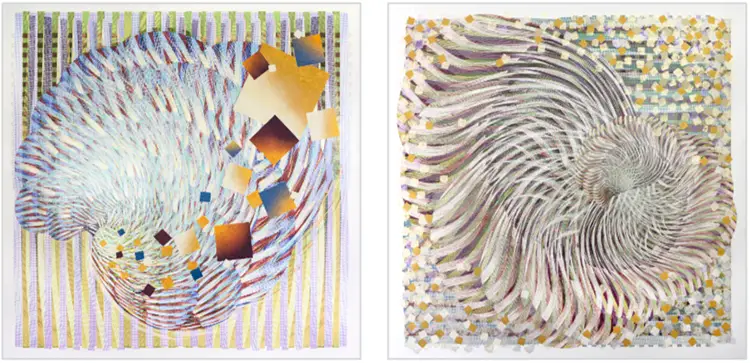
Olga Burkard: Visual Languages of Memory and Metamorphosis
The core of Burkard’s work lies in abstraction—fluid, intricate, and rich in emotional undercurrents. Her compositions are often bold and elaborate, revealing an affinity for maximalist expression that still holds space for contemplation. She weaves digital drawing with traditional methods, producing surfaces where spontaneity meets structure. A distinctive characteristic of her style is the use of basic geometric elements, especially dots and lines, which she treats not as mere shapes but as symbols capable of infinite variation. This minimalist vocabulary, much like computer code, allows her to explore complexity through repetition and subtle shifts.
Themes of transformation, introspection, and imagined realities permeate her art. She gravitates toward the liminal—spaces where memory, identity, and nature blur into one another. These are not direct narratives but visual explorations of emotional transitions and unspoken experiences. Her work often captures that elusive moment between awareness and change, where the internal pulse of life becomes visible in shape and color. There is a quiet desire in her pieces to connect—to translate private perceptions into universal symbols that resonate across cultural and personal boundaries.
A particularly significant work for Burkard is Dream, a large-scale piece that marked her participation in her first group exhibition at Mabe Gallery in Geneva. Inspired by a recurring childhood dream of flight—not with wings, but through sheer will—the piece fuses digital drawing with hand-painted acrylics and collage. Fine lines stretch across the background like delicate air currents, while golden butterfly forms float amidst soft circular patterns. Dream captures a liminal space, hovering between fantasy and embodiment, imagination and action. For Burkard, this artwork stands as a personal manifesto—a visual expression of belief in unseen forces and the courage to trust them.
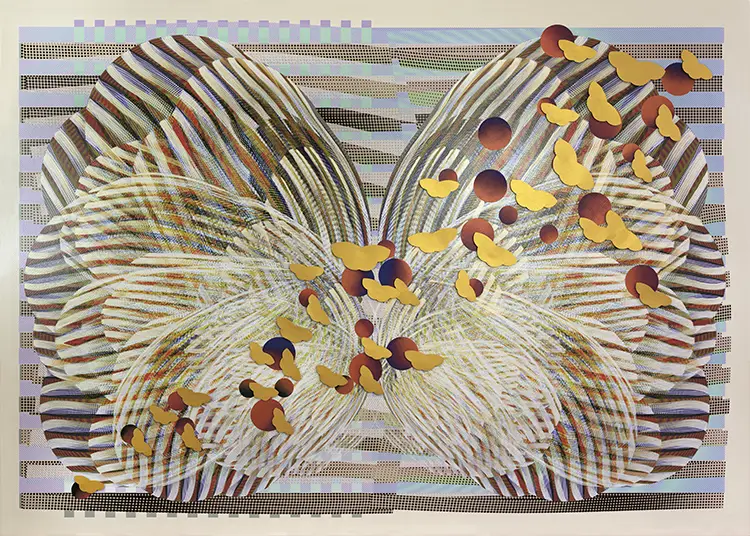
Inventing Inner Ecosystems: Art as Immersive Space
Burkard’s studio practice reflects the same flexibility and openness as her art. Her creative environment is divided between digital and physical stations—a dynamic interplay between screen and surface, algorithm and brushstroke. The workspace is not merely functional; it is a fluid space where light, silence, and motion coalesce into creative momentum. Natural light is essential, providing clarity and softness. A large table accommodates various materials—paint, paper, and tools—allowing her to shift from digital drawings on her iPad to tactile experimentation with collage and acrylic. When her focus locks in, distractions dissipate. Time slows, and the process becomes almost meditative.
While she has not limited herself to one medium, Burkard appreciates the distinct expressive capacity of each. Digital tools offer precision and infinite modulation, enabling her to create densely layered compositions. In contrast, paint gives weight and texture, grounding her ideas in physicality. Printmaking introduces a sense of permanence, preserving fleeting visual impulses. Her methodology is guided less by medium than by message—whatever best serves the emotional or conceptual intent of the piece. This non-hierarchical approach has become central to her evolution, allowing her to shift gears and embrace experimentation without losing coherence.
Currently, she is nurturing a larger ambition—an immersive installation built around a series of over thirty pieces collectively titled Unseen Life. This imagined ecosystem consists of forms that feel sentient yet unfamiliar, embodying the invisible life beneath surfaces and within us. The vision is to create a walkable experience, where visitors enter a space entirely enveloped by these strange and compelling forms. It’s not just about visual engagement but about creating a sensory and emotional dialogue with the unknown. For Burkard, Unseen Life represents a synthesis of everything she values—imagination, transformation, and the ability of art to pull the inner world outward.
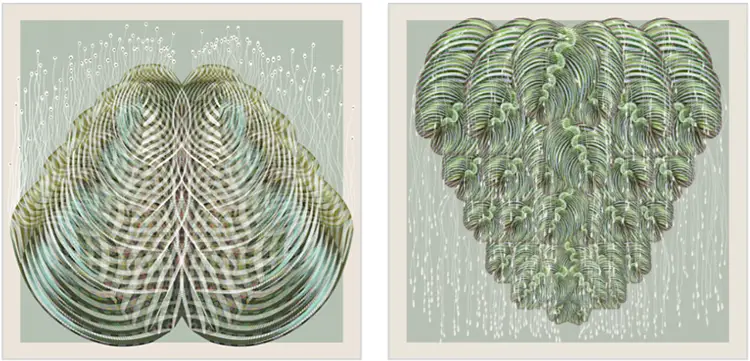
Olga Burkard: The Influence of Form and the Silence Between
Burkard’s visual language draws strength from both cultural legacy and personal encounters. She finds resonance in artists who wield simplicity with intention, transforming fundamental forms into vessels of meaning. Kazimir Malevich’s stark compositions have shaped her understanding of how a single shape can evoke profound emotional responses. Similarly, the work of Mexican abstract artist Vicente Rojo has left a lasting impact. Her experience designing exhibition catalogues for Rojo was not just professional—it deepened her appreciation for visual restraint and emotional depth. His ability to navigate abstraction with clarity continues to inform her decisions around form, color, and rhythm.
In addition to these formal influences, Burkard is deeply connected to the visual culture of her roots. The vibrant traditions of Mexican folk art—its intricate patterns, saturated hues, and animated sensibility—surface subtly in her compositions. These visual memories, shaped by community festivals, crafts, and textiles, contribute to her attraction to pattern and density. However, she refracts these influences through a contemporary lens, allowing them to echo rather than dominate. There’s a sense of honoring the past while reimagining it, of grounding the abstract in the culturally familiar.
Nature, too, plays a silent but vital role in her process. Not in the conventional sense of landscapes or flora, but in the structural intelligence of living systems. She observes how natural forms evolve and adapt, how chaos can produce symmetry, and how invisible forces organize growth. These observations become translated into her work—not through literal representation but through visual metaphor. Whether it’s a pattern of lines mimicking wind, or abstract shapes suggesting cellular life, there’s a quiet biology to her compositions. It is this blend of intellectual curiosity, cultural resonance, and intuitive response that continues to shape her journey—always moving, always unfolding.
